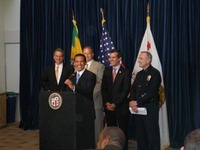Hello again. I am Senior Lead Officer Deon Joseph. As you know, I am the Liaison between the homeless community and LAPD Central Community Police Station. As Safer Cities rolls along, I must say that I am proud of what we have accomplished thus far.
As our efforts spread throughout the skid row area, it appears that my desire of a crime free environment for the homeless, business, and service communities is becoming a reality. As a police officer, there were many days when I felt that real change in this community would never come to pass. I never really felt that people outside of this station cared like I did about the people of skid row. But now with the right leadership in place here, we are making what was once said to be impossible, possible.
As I walk the streets of my area, it pleases me to see less homeless and mentally ill individuals wandering the streets with black eyes, and swollen cheeks. Fewer individuals are running to my patrol vehicle pleading for assistance after being brutalized by gang members, and other criminals within the midst of the homeless community.
We have been allowed to police aggressively and with compassion which shows this skid row community that what we are doing does not come from a place of malice or as an agenda for development interests as our detractors tout.
As I mentioned in each of my prior blog entries, there are those that want us to fail. One of them is a small activist group who claims to be “for the homeless.” This group hides the truth from their willing listeners by feeding them perverted versions of the real reasons we are down here.
When I first met this group I truly believed that their ultimate goal for the community was a positive one. But when you have to lie, embellish or demonize your perceived enemies to do so, it leads me to question what they really stand for. Are they really for the homeless, or just for their goals.
The real conflict between groups like these and the Police Department is a contrast in ideologies. Most activists today believe that their agenda is far more important than the individual human being affected by the situation they claim to be trying to improve. By this I mean that they do not care how many people get stabbed, overdose, or robbed on skid row. It doesn’t matter how many officers’ good names they smear, or how long they stymie the system, as long as in the end they get what they what they want. In their minds, the end justifies the means.
This is in direct conflict of our objective, which has nothing to do with any agenda; it is just our job. And that job is to protect every single individual that lives, works, or provides a service in the skid row area to the best of our ability on a daily basis.
They use huge fancy words like “Criminalization” and “Gentrification” to vilify the image of our officers. From the outside looking in, they sound pretty impressive. While touting their rhetoric, they conveniently leave out the drug dealing, the gang violence, and prostitution that occurred right outside of their office on a daily basis before the inception of Safer Cities. The truth is, we cannot “criminalize” anyone. If you don’t break the law, you won’t get a ticket or go to jail. For far too long, people in skid row were pretty much allowed to break any law they wanted. Due to groups like the one I speak of and powerful attorneys who back them, the criminal element in the area saw their lawless behavior as a “Civil Right.” Also due to a lack of resources at the time, there was very little we could do to curb it.
In the latest edition of their newsletter, I was appalled by their support of light sentences for drug dealers, who have for years thrived from poisoning or assisting the poisoning of this community which I believe is designed to rehabilitate those in need on skid row.
As I stated, there are people who profit from keeping people broke, uneducated and high. I truly believe that this group and groups like it do not want crime and lawlessness in skid row to stop because it does not benefit them. The reason why is simple. These groups are funded via private donations. If there is no one on the street overdosing, defecating, or prostituting in tents, it becomes harder for them to go to their donors and beg for money using sob stories of how they need funding to stop homelessness. They hide from their donors the fact that the driving force keeping people down and out on the row is narcotics and the crime it produces. They also fail to disclose that no amount of housing or drug programs that may come to this area will do a bit of good unless we rid this community of the criminal element that drive people to the drug programs over and over again.
To me, they get more of a kick from “sticking it” to the police department, than becoming a partner with us in protecting the homeless. In their newsletter, it is not the gang members or drug dealers that are the brutes, though they unmercifully cause some of the most heinous atrocities in the Skid Row area. But we are the brutes when we try to enforce laws that truly keep these atrocities from happening.
That is the reality of skid row. If we let them tell it, we are helping no one. But if you ask the service providers who happily report a jump in people seeking their services, street dwellers and business owners who feel safer, I’m sure you will get a different response.
This group claims to be the “voice of the homeless” community, but they are not. They are the same handful of people in orange shirts who routinely stage protest and call us monsters for trying to stop the crime that has crippled this community for decades. At every chance they repeatedly disrupt meetings in order to confuse the community so they do not understand our true purpose. I truly believe that if this group and groups like it would spend as much time and energy protesting the gang members and drug peddlers, we wouldn’t have the need for a safer cities initiative.
It baffles me as they target us when we enter hotels to rid them of violent criminals and sex offenders, yet they do nothing about elderly members of the community being extorted by gang members within these same hotels. They do nothing about the narcotics packaging and sales that are rampant within these hotels.
I truly believe that our efforts will cause skid row to be a place where the homeless can really benefit from the services provided within the area that we are in full support of. We will let them rant and chant. It’s their right to do so. But we will continue our efforts to truly help the homeless, for I feel we have done more for the homeless then they will ever do.
It was not this group that exposed hospitals dumping patients still in need of medical assistance, we did. This group never challenges the crime syndicates that truly exploit the homeless. Whether we had the resources or not, whether we had the support of other agencies or not, we confronted these individuals to the best of our abilities. When juveniles targeted homeless and handicapped people with violent malicious assaults, it was the Officers of Central Division who put a stop to it. While they beg and cry for more programs, we refer people to programs. While they sang parodies of Christmas carols, we gave out care packages to homeless people.
These activist are quick to videotape us when we arrest someone. They make up their own biased minds as to why, but when they observe us providing medical care and shelter for the homeless they turn the cameras away. They only want the public to see what they want the public to see, but refuse to tell the truth. We do not hide from their cameras. In fact, I welcome them for we have nothing to hide. So let them have their activism. We are about action, and changing the face of skid row from a place of lawlessness, to a place of true healing and rehabilitation for the homeless.
But don’t take my word for it. I urge anyone willing to see the side that some news reporters won’t show you, and activist won’t tell you, to come on down to skid row for one of our community walks. We can meet in person and I vow to be honest, open and candid. Just E-mail me at 32511@lapd.lacity.org, and I will give you the next date. Looking forward to it.
Yours truly,
Senior Lead Officer D. Joseph.



Recent Comments